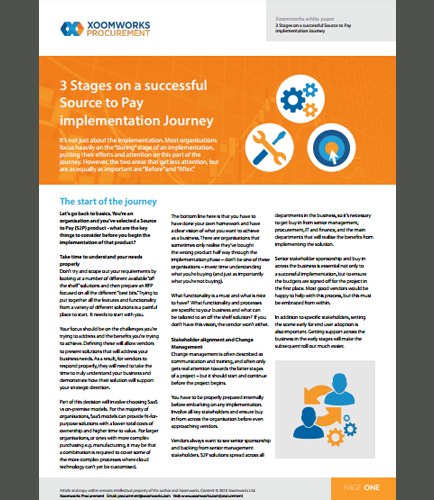
PROCESSING. PLEASE WAIT...



White Paper: Xoomworks BI
Source to pay provides complete end- to-end outsourcing solution. Processing thousands of invoices, supplier data, purchasing requisitions and expense details is a burden. In order to overcome this challenge, an organization needs a procurement process to manage purchasing, sourcing events and improve business performance.
Source to pay process spreads across all the departments in businesses and suppliers in a way that no other system does.
Procurement process not only creates a better strategic sourcing approach that delivers greater savings and enhanced visibility, but also increases control and ongoing process.
This white paper teaches you three stages involved in successfully implementing a procurement solution for source to pay. It focuses on six areas and opportunities that need focus during implementation of a source to pay solution:
Choosing the right implementation partner
Early and ongoing stakeholder engagement and communication
The mechanics of data and integration
Implementing Saas on cloud storage
Internal drive and motivation
Adding efficient content
By: BP Logix
This white paper explains how business values enable you to drive your business applications with real-time data Driving Business applications with real-time data bring a new dimension to business values in building business applications. BP Logix came up with the intelligent Business Process Management (BPM) solutions for rapid application development, through data obtained from System of Records and System of engagement. Configure the business value through existing resource. In this white paper on “Driving Business Applications with Real-Time Data,” discover more on driving real-time business data that will guide you on: Accessing systems of record from the resulting data to configuring appropriate information within a business application Using Data virtualization or Data Federation techniques to configure real-time data from System of Record Configuring to represent scalars or lists, and by combining business value properties with real-time data, can generate records and tables
By: Signavio
An enterprise-wide process modeling is the most agile way to conduct a successful digital transformation as it requires a top-down examination of the performance, quality and sustainability. Digital transformation is an essential step in the evolution of many businesses today. Process modeling has grown from creating a diagram or report figure that explains a business problem to a transformational practice that can organize the way a business is monitored, controlled, and measured. This whitepaper discusses why businesses should consider an enterprise-wide process modeling approach for competing through digital transformation. Key takeaways of this white paper: Take Process Models out of isolation within your business Nurturing digital business transformation by focusing on your process From business process mapping to enterprise business process modeling Ways to instigate enterprise-wide process modeling


 2025 All Rights Reserved | by: www.ciowhitepapersreview.com
2025 All Rights Reserved | by: www.ciowhitepapersreview.com